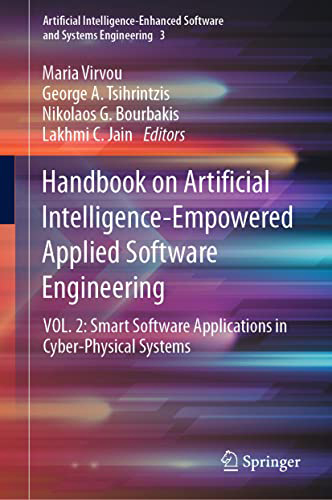Book Review

|

|
1. Handbook on Artificial Intelligence-Empowered Applied Software Engineering, Vol. 1: Novel Methodologies to Engineering Smart Software Systems
Editors: Virvou, Maria; Tsihrintzis, George A.; Bourbakis, Nikolaos G.; Jain, Lakhmi C.
Springer 2022, pp. 342, ISBN 978-3-031-08202-3
Vol. 2 in Springer Book Series entitled Artificial Intelligence-Enhanced Software and Systems Engineering(https://www.springer.com/series/16891)
2. Handbook on Artificial Intelligence-Empowered Applied Software Engineering, Vol. 2: Smart Software Applications in Cyber-Physical Systems
Editors: Virvou, Maria; Tsihrintzis, George A.; Bourbakis, Nikolaos G.; Jain, Lakhmi C.
Springer 2022, pp. 209, ISBN 978-3-031-07650-3
Vol. 3 in Springer Book Series entitled Artificial Intelligence-Enhanced Software and Systems Engineering(https://www.springer.com/series/16891)
Computer programming, computer use, and human-computer interaction are no longer what they used to be. Indeed, traditional/conventional computer programs consisted of a set of step-by-step instructions that were executed sequentially to achieve proper processing of input data and subsequently produce desired corresponding output data. The idea was that the programmer was aware of the proper input-output relation and used software tools (e.g. a high level computer language) to encode it into a computer program.
However, advances in the theory, methodologies and applications of Artificial Intelligence have been disrupting traditional software engineering and causing a paradigm shift. Not only part of the software development process is gradually being automated and undertaken by other software modules, but even that software piece that humans develop evolves on its own and to the point that its developers are not aware of how it functions. Notably, the current trend is to develop software that does not process data in a pre-defined way, but rather incorporates data-driven methodologies that allow it to discover the proper, perhaps even optimal, data processing on its own and from the data itself.
This trend of empowering software with Artificial Intelligence enhancements is expected to positively affect all aspects of human society activities, including but not limited to, agriculture, healthcare, the energy sector and industry. Additionally, it will contribute towards increasing the degree of reliability of cyber-physical systems and lead to trustworthy autonomous systems. Thus, a new, multi-disciplinary research area has been forming, along with a need for a research forum where researchers can deposit new knowledge in this area, exchange ideas and initiate discussions on related research topics.
Profs. Maria Virvou, George A. Tsihrintzis, Nikolaos G. Bourbakis and Lakhmi C. Jain have identified the lack of such a research forum and initiated a new Springer series under the title ARTIFICIAL INTELLIGENCE-ENHANCED SOFTWARE AND SYSTEMS ENGINEERING. Topics of interest to this series follow the five directions:
1. Incorporating Artificial Intelligence enhancements into software
2. Developing Artificial Intelligence tools for Software Engineering
3. Merging Software Engineering with Knowledge Engineering
4. Software Engineering for developing Artificial Intelligence and Machine Learning systems
5. Innovative applications of Artificial Intelligence-empowered Software Engineering.
Profs. Virvou, Tsihrintzis, Bourbakis and Jain have initiated the series with an impressive Handbook on Artificial Intelligence-empowered Applied Software Engineering. Their Handbook is a two-volume work, consisting of Vol. 1: Novel Methodologies to Engineering Smart Software Systems and Vol. 2: Smart Software Applications in Cyber-Physical Systems. Besides corresponding introductory chapters, the first and second volumes contain eleven and ten additional chapters, respectively. The first volume presents its readers with (i) a Survey of Recent Relevant Literature (1 chapter), (ii) Artificial Intelligence-Assisted Software Development (5 chapters) and (iii) Software Engineering Tools to develop Artificial Intelligence Applications (5 chapters). These chapters discuss general methodologies that can be applied in several applications areas and set the path for the second volume. The second volume includes a number of specific Smart Software Applications in (i) Scientific Document Processing (2 chapters), (ii) Enterprise Modeling (3 chapters), (iii) Education (2 chapters), (iv) Healthcare and Medicine (2 chapters), and (v) Infrastructure Monitoring (1 chapter). Chapters in both volumes have been authored by invited internationally recognized researchers with expertise in the chapter topic.
Overall, the Handbook is a high quality edition and a great addition for many readers. In particular, I have been quite impressed by the breadth of the topics covered in the two volumes. I have also been particularly impressed by the fact that the editors have managed not to sacrifice the corresponding depth of topic coverage. Above all, however, I have been impressed by the fact that the readers become able to apply software empowerment methodologies in their own application areas, based on the general methodologies in the first volume and the developed applications in the second volume of the Handbook.
Notably, the blend of theory and applications exhibits an impressive balance that makes the Handbook attractive to people coming from various backgrounds. Moreover, the reader does not have to be an expert in Software Engineering to understand most of the material covered in the Handbook. In addition, I find that the plethora of topics covered in the Handbook may constitute a point of inspiration for people interested in delving into this new area, either by developing new or expanding the presented theories, or by applying the presented methodologies in other domains.
Concluding, I warmly congratulate the editors for their superb job and I recommend this Handbook as an essential addition to both libraries and individual readers, whether they are professors, graduate students, practitioners and other specialists in Artificial Intelligence- and Software Engineering-based technologies or general readers. I am confident all types of readers will benefit from this Handbook and become readier to engineer and develop Artificial Intelligence-Empowered Software.
Miltos Alamaniotis, Ph.D.
Associate Professor
University of Texas-San Antonio, TX, USA




